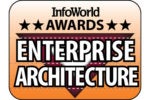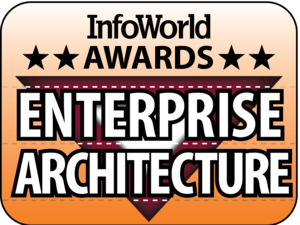Enterprise architecture (EA) serves two main purposes: to provide a framework for collaboration between business and IT and to offer a pivot point for transformational change. To be effective change agents, enterprise architects must possess a deep understanding of business process -- and grasp both the potential and the practical limits of new technology solutions.
Despite their crucial role and unique combination of skills, enterprise architects seldom get the recognition they deserve. Last year, InfoWorld and Forrester Research decided to rectify that -- with the first annual InfoWorld/Forrester Enterprise Architecture Awards, which honored five organizations whose EA initiatives had a major impact on the business.
[ See more of this year's best of the best, including tech leaders who won the Technology Leadership Awards, and the open source software winners of the InfoWorld Bossie Awards. ]
This year, with so many strong nominees, we chose a total of six winners: American Express, Bayer Healthcare, First Data, the Singapore Ministry of Education, Procter & Gamble, and USAA.
Each of the six took a different path to earning the 2011 Enterprise Architecture Award. But in all cases, despite challenging economic times, these companies' EA practice offered a new way forward, streamlining processes and enabling more effective use of IT resources. We at InfoWorld and Forrester Research salute the fine work performed by our 2011 winners.
American Express
With mobile payments all the rage these days, the payments industry -- and American Express in particular -- is undergoing a major transformation. To address the complexity of new product and service delivery channels, as well as the need for greater agility and shorter time to market, American Express's EA practice was charged with helping the company deliver a consistent, global, integrated customer experience based on converged services that run on a common application platform.
The EA practice has successfully addressed the needs of the business by delivering reference architectures and road maps that promote standardized application architectures, facilitate innovation, and enable rapid product development. In partnership with portfolio architects, the EA practice manages application architecture across multiple business solution delivery teams and develops business-aligned IT strategies. Each strategy contains a road map of initiatives that translates to measureable action and IT commitments to the business.
Road mapping is a core planning competency for architecture, engineering, service, and operations. It supports such business and IT goals as service management, portfolio simplification, prioritization, and IT-business alignment. Using a common tool, a consistent lifecycle management standard, and a standardized architecture governance process, three types of road maps are created:
- Technology road map
- Reference architecture road map
- Utility/capability road map
American Express's reference architectures have enabled business solution delivery teams to bring products and services to market faster by reducing infrastructure procurement and provisioning from months to a matter of days and, in some instances, hours. The use of reference architectures has resulted in fewer service outages, increased standardization of infrastructure, improved mean time to repair, and a dramatic decrease in support costs. Converged architectures based on reference architectures meant that the first quarter of 2011 had the fewest problem tickets in American Express's IT history.
During the next 12 to 18 months, American Express is extending its road map coverage to encompass the rationalization of business capabilities and the maturing of SOA. Within the next few years, American Express plans to develop new reference architectures mapped to business-aligned capabilities, along with a new taxonomy to align EA and IT services with business needs.
Bayer Healthcare
With 55,000 employees spread around the world and a rich history of mergers and acquisitions, Bayer Healthcare is a big, complex organization. In 2009, it launched its Enterprise Architecture Management program with the creation of a global, Web-based Standards Management Platform that today serves the entire Bayer group.
Bayer's program is designed to act as a "knowledge bridge" between business operations and IT. Business and IT objectives include:
- Increase business agility through optimization, simplification, and consolidation of processes
- Drive value from existing platforms, increasing cost efficiency
- Support lifecycle management of IT assets in a rapidly changing business environment
- Improve process and system knowledge for better future-state planning
- Increase the efficiency of merger, acquisition, and divestiture business processes
- Unify business and technology decision-making across the enterprise
In 2010, the team began an aggressive program to optimize their application portfolio. One of the deliverables from the project was a complete application repository, the Bayer Application Portfolio Portal, which would include all related processes. The biggest challenge Bayer faced was data input and management. In the past, data had been collected using surveys sent to various regions, which were difficult to reconcile and keep current. The team set a goal to liberate the data from many repositories around the globe and unify it in a single, consolidated repository.
The online portal is available to all IT and business managers across the company. Users can log in at any time to find an application and its related process data. The repository builds in application lifecycle management and proposals for specific activities, such as migration, integration, toleration, and elimination.
The repository includes assessments from business, technology, and financial perspectives and identifies application gaps, overlaps, and improvement opportunities. Applications are inventoried and registered against key metrics, and data integrity is maintained through an ongoing data stewardship program. Of particular importance was the need to build in strong collaboration tools, so business owners and IT could more easily share and discuss change scenarios. To facilitate this, reports and visualizations can be generated directly from the portal. For instance, the Application Technology Risk Summary Heat Map uses color to illuminate specific application risk areas to drive rapid and early problem mitigation.
Cost reductions on the operational baseline were identified by recognizing opportunities to consolidate, harmonize, or decommission. One example from the North America region showed a potential savings of 30 percent by consolidating 15 applications that accounted for more than 25 percent of the annual run costs.
The increase in efficiency extends to processes associated with EA itself. For example, Bayer expects that the next cycle for future IT landscape planning can be accelerated dramatically, with data gathering and analysis reduced by 60 percent to 70 percent.
First Data
So much is made of IT-business alignment that it's held up as a kind of nirvana for enterprise architecture teams. First Data, a provider of transaction-processing solutions with more than $10.4 billion in revenue and 24,500 employees in 35 countries, appears to be well on its way to reaching this state of enlightenment.
First Data's global EA function has created a framework for strategic technology programs to coordinate technology adoption and development in a manner that maximizes value. These road maps are pivotal as the company creates go-forward technology stacks with more contemporary, innovative technologies to enable dramatic improvements. Through them, First Data will transform three technology layers: application (SOA, platform rationalization), information (master data management, BI, data warehouse consolidation), and infrastructure (data center consolidation, internal private cloud, provisioning automation).
EA is intertwined with nearly every aspect of First Data's business. Its ability to drive product transformation is critical; this project will rationalize and consolidate product offerings, driving efficiency, simplicity, cost effectiveness, and agility. First Data expects it to become a core function of the company's 16,000-person global operations and technology organization.
As owner of these road maps, EA is responsible for ensuring effective collaboration with development and vendor partners to ensure the benefits of emerging technologies are effectively captured and that the company continues to push the limits of technology in developing internal capabilities and future product offerings. This includes leveraging internal private clouds with provisioning automation, integrating real-time communication services (IM, telepresence, videoconferencing), deploying consumer technologies (iPads), and incorporating IBM's Watson technology to manage 120TB of enterprise data migrating to a consolidated warehouse.
Although this is a long-term process for First Data, the results of alignment and EA initiatives can already be felt. As the company continues its global growth, it is positioned to execute and continue absorbing volume increases and new functionality while holding approximately $2 billion in operating expenses flat year over year.
The latter is critical to the company's goal of adding $1 billion in incremental EBITDA (earnings before interest, taxes, depreciation, and amortization) by 2013. Through a global command center strategy, the company plans to cut the number of outside software vendors, reduce the number of application platforms, and reduce the number of programming languages from 11 to 3. Even as First Data holds the line on operating costs, it plans to add critical functionality, such as a 24/7 view of global payment systems.
Singapore Ministry of Education
The story is familiar: IT expenditures increase, yet uncoordinated expenditures result in a diverse technology landscape ranging from mainframe to web, with widely varying technology expertise. In other words, the Singapore Ministry of Education suffered from a high TCO without a clear ROI. Siloed systems led to redundancies across user groups, limited IT efficiencies, and cumbersome systems that prevented timely responses.
The Ministry faced an overwhelming need for synergy and optimization. They embarked on an EA journey to increase business value by leveraging IT and to continually improve user satisfaction and the cost-effectiveness of IT investments. They achieved their aims through a combination of EA and IT governance.
The Singapore Ministry of Education adopted an SOA approach. By enabling IT systems to share and reuse common data services (for example, the Student Information Service) and common business services (such as computation of results aggregates), the organization could respond with agility to the evolving education landscape and its changing policies. For example, when schools introduced a new syllabus or curriculum, the affected systems were able to construct new business processes in a shorter amount of time.
How did the Ministry of Education get rid of the waste? All IT systems were required to align with the architecture strategy from inception. Reviews of affected user divisions were conducted to optimize and streamline business processes. The EA Committee reviewed business cases and architecture for all new investments -- from the initial problem definition through final design -- and identified potentially reusable business and data services.
Because EA is a relatively new discipline, significant senior management commitment was required to make the necessary process, role and cultural changes. The EA program put in place a performance report card, measuring value, maturity, and business satisfaction.
The results have been outstanding. Business units are more conscious of how a project ultimately contributes to the Ministry's goals. IT is progressively becoming more agile and is cutting unnecessary software or hardware costs. Even more telling is the consolidation and cost savings the Ministry has achieved: The Ministry has reduced the number of systems in needs to maintain and support by 44 percent, saving over $25 million through economies of scale.
Instead of being hostage to a legacy of dysfunctional IT, the Singapore Ministry of Education has transformed into an agile organization that embraces change.
Proctor & Gamble
For Proctor & Gamble, it's all about consumers: understanding their needs and tastes and delivering better products faster across global markets. To better address these markets, the company's strategy is to digitize end-to-end -- simplifying processes, integrating across seams, and accelerating time to market. The ultimate goal is to reach new markets faster and impact more consumers in more ways.
The EA team established a BAF (business architecture framework), to digitize and simplify its end-to-end processes. The framework has four major components:
- Core process and information maps
- Shared service architecture mapping into the company processes
- Uniquely defined digital metrics on process standardization, automation, real time information, and employee technical competency
- Platform of tools to maintain the data









